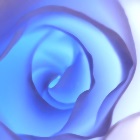 It goes without saying there is a wide range of flower colours in roses, perhaps the most of any cultivated plant in the world. But there is one noticeable colour missing: Blue. By blue, I mean a ‘true blue’ like the colour you find with delphiniums, morning glory, Himalayan poppy (Meconopsis) or gentians.
It goes without saying there is a wide range of flower colours in roses, perhaps the most of any cultivated plant in the world. But there is one noticeable colour missing: Blue. By blue, I mean a ‘true blue’ like the colour you find with delphiniums, morning glory, Himalayan poppy (Meconopsis) or gentians.
A Bit of History
Many people think we have already got blue roses with those that we grow in the lavender and mauve shades. This isn’t the case and if you compare the likes of Blue Moon, Starlight, Superbowl and Blueberry Hill to the plants mentioned above, you’ll know where I am coming from. Remember there is no such thing as a blue rose and I’ll get onto the reason soon.
For many years, rose breeders tried to create the elusive blue rose by conventional breeding techniques. There are a few stories around of some very blue roses that got thrown away before the quest started and while the mauve roses certainly got bluer, nobody got a true blue rose.
Now for the reason why we don’t have any blue roses. Simply, roses don’t have the blue genes required for the production of the blue pigment called delphinidin. Neither conventional breeding techniques nor a mutation would result in a blue rose occurring.
Instead, genetic modification has been used by several companies in Australia, Japan and the United States to try and develop a true blue rose. By taking the blue gene from petunias, Florigene in Australia were able to start producing carnations (another plant that has no blue genes) that were blue and the first plants were released in 1996. None are available in New Zealand.
Development of the Blue Rose
There have been many issues arise from developing a blue rose. First, the pH (the measure of acidity) in the petals is too acid for the blue genes to survive and basically turns them pink like a hydrangea. No simple fix here.
There is also a problem with the interaction between the blue genes and the other pigments that form the colours in the petals. Other pigments re strong competitors and will basically not allow the blue to express itself in the petals. It is likely a true white rose with all the pigments removed would need to be created and the then blue genes included for the colour to really show up.
Then there are all the issues around genetic modification which are too big for a column like this. There is also the cost. I am told $20 million US dollars had been spent on it a few years ago now and this would have increased since then.
There have been some developments in this area with a blue rose released commercially in Japan a few years ago. I was able to see a bloom as part of the World Rose Convention in Osaka in 2006. The verdict; not blue enough and a bit of a disappointment. I could not even get a photo but you can see one via this link.
Are we any closer? No, but there is hope. I feel a blue rose would help bring some much-needed publicity and exposure to the roses, even if the eventual rose is only for the cult flower market. Of course, there are issues surrounding genetic modification which need to be properly debated. At the end of the day, though, any blue rose must look and hopefully smell like a proper rose.










Join the Discussion
Type out your comment here:
You must be logged in to post a comment.